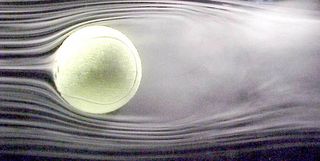Some Recent Researches on the Motion of Fluids Monthly Weather Review
What Is Fluid Dynamics?

Fluid dynamics is "the branch of applied scientific discipline that is concerned with the movement of liquids and gases," according to the American Heritage Lexicon. Fluid dynamics is one of two branches of fluid mechanics, which is the study of fluids and how forces affect them. (The other co-operative is fluid statics, which deals with fluids at residual.)
Scientists across several fields study fluid dynamics. Fluid dynamics provides methods for studying the evolution of stars, ocean currents, weather patterns, plate tectonics and fifty-fifty blood circulation. Some important technological applications of fluid dynamics include rocket engines, current of air turbines, oil pipelines and air conditioning systems.
What is menses?
The movement of liquids and gases is more often than not referred to equally "flow," a concept that describes how fluids conduct and how they interact with their surrounding environment — for example, water moving through a channel or pipe, or over a surface. Flow can be either steady or unsteady. In his lecture notes, "Lectures in Unproblematic Fluid Dynamics" (Academy of Kentucky, 2009) J. M. McDonough, a professor of technology at the University of Kentucky, writes, "If all properties of a flow are independent of time, then the flow is steady; otherwise, it is unsteady." That is, steady flows exercise non change over time. An example of steady period would be water flowing through a piping at a abiding rate. On the other paw, a flood or h2o pouring from an old-fashioned hand pump are examples of unsteady flow.
Catamenia tin can also exist either laminar or turbulent. Laminar flows are smoother, while turbulent flows are more than chaotic. Ane of import factor in determining the country of a fluid'south menstruum is its viscosity, or thickness, where higher viscosity increases the trend of the period to be laminar. Patrick McMurtry, an applied science professor at the University of Utah, describes the difference in his online class notes, "Observations About Turbulent Flows" (University of Utah, 2000), stating, "By laminar flow we are by and large referring to a smooth, steady fluid motion, in which whatever induced perturbations are damped out due to the relatively strong gluey forces. In turbulent flows, other forces may be acting the annul the action of viscosity."
Laminar catamenia is desirable in many situations, such as in drainage systems or plane wings, because information technology is more efficient and less free energy is lost. Turbulent flow tin can be useful for causing dissimilar fluids to mix together or for equalizing temperature. According to McDonough, nigh flows of interest are turbulent; however, such flows can be very difficult to predict in detail, and distinguishing between these two types of period is largely intuitive.
An important cistron in fluid flow is the fluid's Reynolds number (Re), which is named after 19th century scientist Osborne Reynolds, although it was kickoff described in 1851 past physicist George Gabriel Stokes. McDonough gives the definition ofRe every bit, "the ratio of inertial to viscous forces." The inertial forcefulness is the fluid's resistance to change of motility, and the viscous force is the amount of friction due to the viscosity or thickness of the fluid. Note thatRe is not only a property of the fluid; it also includes the conditions of its menstruation such as its speed and the size and shape of the conduit or any obstructions.
At lowRe, the flow tends to exist smooth, or laminar, while at highRe, the flow tends to be turbulent, forming eddies and vortices.Re tin can be used to predict how a gas or liquid volition flow around an obstacle in a stream, such as water around a bridge piling or current of air over an aircraft fly. The number tin can also be used to predict the speed at which menses transitions from laminar to turbulent.
Liquid flow
The report of liquid flow is called hydrodynamics. While liquids include all sorts of substances, such as oil and chemical solutions, by far the almost common liquid is water, and most applications for hydrodynamics involve managing the menstruum of this liquid. That includes alluvion command, functioning of city water and sewer systems, and direction of navigable waterways. [Gallery: Dreamy Images Reveal Beauty in Physics]
Hydrodynamics deals primarily with the flow of h2o in pipes or open channels. Geology professor John Southard's lecture notes from an online course, "Introduction to Fluid Motions" (Massachusetts Institute of Technology, 2006), outline the main divergence between pipage flow and open-channel menses: "flows in closed conduits or channels, like pipes or air ducts, are entirely in contact with rigid boundaries," while "open up-channel flows, on the other hand, are those whose boundaries are not entirely a solid and rigid material." He states, "important open-channel flows are rivers, tidal currents, irrigation canals, or sheets of water running across the ground surface afterward a rain."
Due to the differences in those boundaries, unlike forces affect the 2 types of flows. According to Scott Post in his book, "Applied and Computational Fluid Mechanics," (Jones & Bartlett, 2009), "While flows in a closed pipe may be driven either by pressure level or gravity, flows in open channels are driven by gravity alone." The pressure is adamant primarily by the acme of the fluid to a higher place the bespeak of measurement. For example, most metropolis water systems utilise h2o towers to maintain abiding pressure in the system. This divergence in tiptop is called the hydrodynamic caput. Liquid in a pipe can likewise be made to flow faster or with greater pressure using mechanical pumps.

Gas flow
The period of gas has many similarities to the flow of liquid, only it also has some of import differences. First, gas is compressible, whereas liquids are by and large considered to be incompressible. In "Fundamentals of Compressible Fluid Dynamics" (Prentice-Hall, 2006), author P. Balachandran describes compressible fluid, stating, "If the density of the fluid changes appreciably throughout the flow field, the catamenia may be treated as a compressible flow." Otherwise, the fluid is considered to be incompressible. 2nd, gas flow is hardly affected by gravity.
The gas most commonly encountered in everyday life is air; therefore, scientists have paid much attention to its flow weather condition. Wind causes air to motion effectually buildings and other structures, and information technology can also be made to move by pumps and fans.
One area of particular interest is the motility of objects through the atmosphere. This branch of fluid dynamics is called aerodynamics, which is "the dynamics of bodies moving relative to gases, especially the interaction of moving objects with the atmosphere," according to the American Heritage Dictionary. Issues in this field involve reducing drag on motorcar bodies, designing more efficient shipping and wind turbines, and studying how birds and insects fly.
Bernoulli's principle
More often than not, fluid moving at a higher speed has lower pressure than fluid moving at a lower speed. This miracle was first described by Daniel Bernoulli in 1738 in his volume "Hydrodynamica," and is commonly known as Bernoulli'south principle. It tin be practical to measure the speed of a liquid or gas moving in a pipage or channel or over a surface.
This principle is also responsible for lift in an aircraft wing, which is why airplanes tin wing. Because the fly is apartment on the bottom and curved on the top, the air has to travel a greater altitude along the superlative surface than forth the lesser. To do this, it must go faster over the pinnacle, causing its pressure level to decrease. This makes the higher-pressure level air on the bottom lift upwards on the wing.
Problems in fluid dynamics
Scientists often endeavour to visualize period using figures called streamlines, streaklines and pathlines. McDonough defines a streamline as "a continuous line inside a fluid such that the tangent at each point is the management of the velocity vector at that bespeak." In other words, a streamline shows the management of the flow at any particular signal in the menses. A streakline, co-ordinate to McDonough, is "the locus [location] of all fluid elements that take previously passed through a given point." A pathline (or particle path), he writes, is "the trajectory of an private chemical element of fluid." If the menstruation does not change over time, the pathline volition be the same as the streamline. All the same, in the example of turbulent or unsteady menses, these lines can exist quite dissimilar.
Nigh problems in fluid dynamics are likewise circuitous to exist solved by directly calculation. In these cases, bug must be solved by numeric methods using reckoner simulations. This surface area of written report is called numerical or computational fluid dynamics (CFD), which Southard defines as "a co-operative of computer-based science that provides numerical predictions of fluid flows." However, because turbulent menstruation tends to be nonlinear and cluttered, particular intendance must be taken in setting up the rules and initial conditions for these simulations. Small changes at the get-go tin event in large differences in the results.
The accuracy of simulations tin be improved by dividing the book into smaller regions and using smaller time steps, but this increases computing fourth dimension. For this reason, CFD should advance as computing power increases.
Jim Lucas is a freelance writer and editor specializing in physics, astronomy and engineering. He is general managing director of Lucas Technologies .
Boosted resource
- NASA Tunnels Examination Lawn tennis Balls
- Science & Technology Review: Reducing Aerodynamic Drag
- International Infinite Station: Fluid Flow Models
Source: https://www.livescience.com/47446-fluid-dynamics.html

0 Response to "Some Recent Researches on the Motion of Fluids Monthly Weather Review"
Enviar um comentário